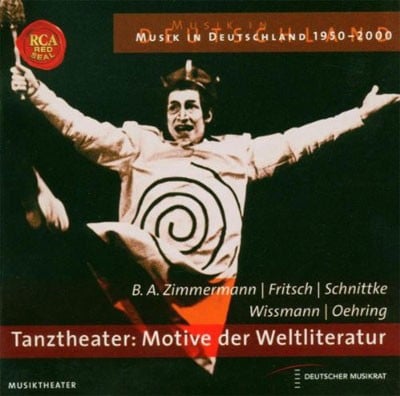Bernarda Albas Haus (with Iris ter Schiphorst)
(The House of Bernarda Alba) (1999)deaf soloist (female), soprano (male); 7 dancers;
elec.gtr-db-live electronics
Abbreviations (PDF)
Bote & Bock
A great piece of world theatre is given new musical expression, in a concentrated and truly contemporary manner, by Helmut Oehring and co-composer Iris ter Schiphorst. The two composers employ idiomatic and, in this constellation, singular techniques: expressing consternation when faced with religious convention and tradition as well as betrayal, violence and death, the Spanish village tragedy is rendered in sign language – accompanied by sampled sounds and charged with musical drama by the piano, guitar and double bass. The only musical protagonist is the soprano. Yet the music is merely a screen for the story which is rendered by the dancers.
Thirteen months after their biggest collaboration, Requiem, was presented by Ictus Ensemble in Paris, Donaueschingen and Brussels in autumn 1998, their new project shows another, though completely different, take on historical and spiritual (Catholic) attachment, tradition and convention. While the Requiem was inspired by Mozart’s requiem mass and Live, their most successful collaboration so far (for singer, violin, cello, prepared piano/sampler and live electronics, premiered in Witten in 1997), was inspired by Schönberg’s Pierrot lunaire, Bernarda Alba’s House is an imaginative musical account of the Spanish drama.
"The company that performed Bernarda in Basle goes further in terms of abstraction than all others who have attempted to translate this play into dance. The fable is interesting only in that it creates a hysterical atmosphere which is intended by Schlömer and Oehring: a pressure cooker of suppressed passions, in danger of exploding almost from the start.
The music is involved in the creation of this atmosphere more actively than with most of the other dance pieces... an unconventional form of music consisting of melodically interpolated noises: sung cantilenas soaring over clusters, nervous sawing of the double bass, electronic explosions behind which, almost inaudibly, Schubert’s Ave Maria or the distant singing of a muezzin unfolds...
For an hour and fifteen minutes the performance works itself into the nervous centre of the audience." (Jochen Schmidt, FAZ, 19.11.1999)
"The three authors are apparently of like minds and perceptions, thus the resulting dance theatre piece is amazingly coherent. Helmut Oehring and Iris ter Schiphorst wrote a score that reciprocates between extreme states of slow-motion leading to standstill on the one hand and musical congealment in piercing noise on the other. Monotonous repetitions, fractures, new starts of the same ideas, loops, some isolated sounds from outside (bells, a bird) and time and again fragments from Bach and Schubert – memories of the past, of a perfect world, a sense of yearning lost in the noise of an age-old grammophone. To Lorca’s characters, Oehring and ter Schiphorst added a peculiar couple, whose function resembles that of the evangelist in Bach’s Passions. In reality, though, the two added characters personify the impossibility of telling a story which is actually set in the world of emotions. One of them is the deaf actress Christina Schönfeld, who recounts the basic story of Bernarda Alba and her daughters in sign language, the other is countertenor Arno Raunig, whose text is naturally incomprehensible, as it is sung in cantilena style, and who literally fills the main characters’ fate with expression. Throughout the whole work the couple seems strangely unwieldy, also in the musical context, because – though doing what you would expect them to do – they are ultimately impossible to understand.
On the basis of this score, Joachim Schlömer produced a choreography for the ensemble of the Basel dance theatre company which was characterised by realistic symbolism, featuring the stage and dress colours (or non-colours) black/white and occasionally red (Frank Leimbach, Gesine Völlm). The only ‘real’ dance is a fatal flamenco. Like the music, the dancing style is dominated by discontinuous, fragmentary elements: disturbances, random activism, eruptions leading to nothing. Only Bernarda Alba, with her slow gait and movements, represents frightening steadiness. In all the premieres, music and dance merged to a black emotional theatre consisting of gesture, movement and sound, uncompromising, unvarnished, brutal, but moving. The dancers of the Basel dance theatre company and the musicians Peter Kowald (double bass), Markus Retschnefki (prepared piano, keyboard) and Jörg Wilkendorf (electric guitar) gave definition to dance and sound. And at last I got hold of a seat in the Hebbel Theatre, to experience the necessity of the Dolby surround acoustics (Torsten Ottersberg)." (Giesela Nauck, Positionen, February 2000)

Arno Raunig / Christina Schönfeld / Jörg Wilkendorf / Peter Kowald / Markus Reschtnewki u.a.
(Deutscher Musikrat - Musik in Deutschland 1950-2000 / Tanztheater / Motive der Weltliteratur)
BMG 74321 73577 2
